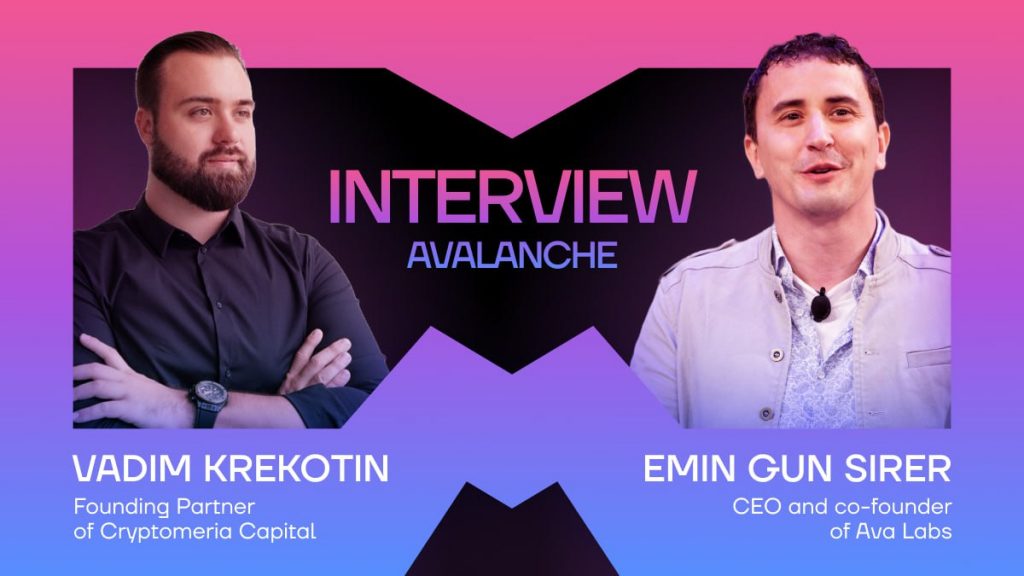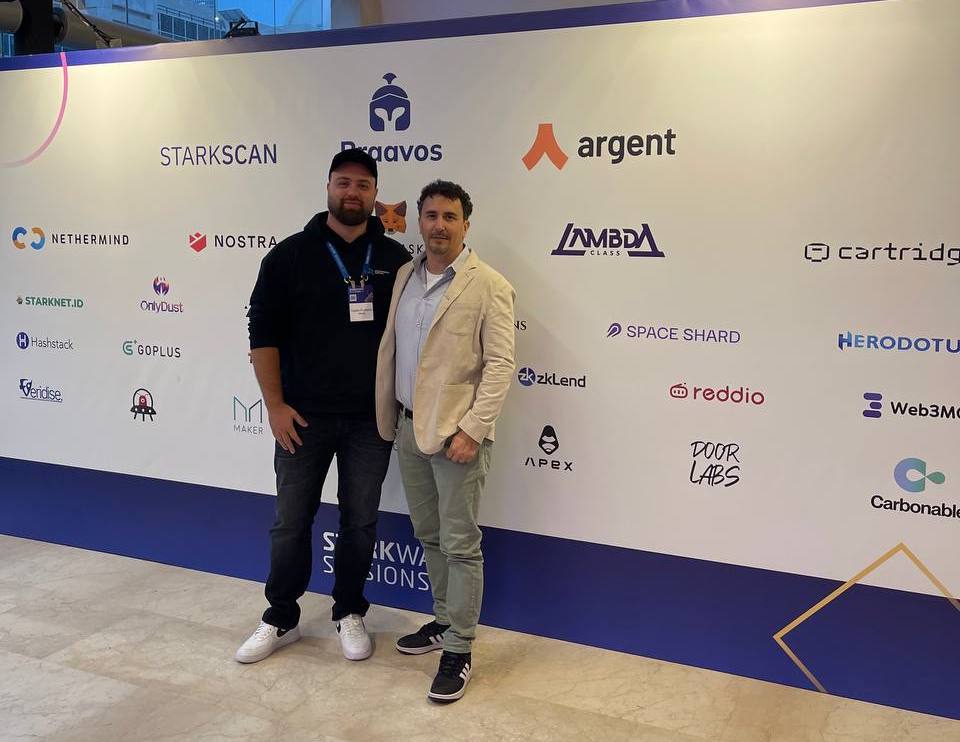Emin Gun Sirer, CEO of Ava Labs, is optimistic about using blockchain technology to solve the failures of centralized custodians

In Brief
At Starkware Sessions 2023, we spoke to Turkish-American computer scientist Emin Gün Sirer, who’s the founder and CEO of Ava Labs, the company behind the Avalanche platform.
Despite last November’s FTX collapse, Emin remains optimistic about the blockchain and web3 spaces.
Avalanche leads the way here, and it’s so fast that you can interact with Avalanche in real time with full finality in the blink of an eye.
Emin expects that the fact that the gas fees are much lower going to be bringing has already brought a brand new audience into crypto.
Avalanche can execute on its own chain, and the full capacity of the system is infinite as opposed to being limited by what you can do in a single chain.

At Starkware Sessions 2023, Vadim Krekotin spoke to Turkish-American computer scientist Emin Gün Sirer, who’s the founder and CEO of Ava Labs, the company behind the Avalanche platform. Despite last November’s FTX collapse, Emin remains optimistic about the blockchain and web3 spaces. He noted that the issue was not a failure of crypto but rather a failure of centralized custodians.

“We ended up having the FTX problem because we veered away from our core principles. We veered away from self-custody and bare assets towards using custodians and intermediaries in a space whose entire value proposition is to eliminate intermediaries, he said.
While the FTX collapse has brought about increased regulatory scrutiny, Emin is confident that the regulations that will come to pass will be reasonable. During the interview, he shared more about his insights on the current state of web3 and the company’s plans for decentralized identity.
Vadim: I’m here with the founder and CEO of Avalanche, Emin Gün Sirer. Please say a couple of words about yourself.
Emin: I am the CEO of Ava Labs, the company behind a lot of innovation in the blockchain space, starting with the Avalanche platform, the core wallet, and the Enclave Markets project, which is building new kinds of exchanges that are immune to the kinds of malfeasance we saw with the FTX collapse. So we are here to build trustless software solutions and have been doing this for some time now.
Vadim: What do you think about the current state of web3? Where do you see it going this year and maybe the next year?
Emin: I am super excited about where we are despite what happened last year, and the reasons for that are very simple: We have finally reached the stage where regular asset managers have accepted crypto assets as a new asset class of its own.
This happened in the last bull cycle, and just about everybody I talk to on Wall Street has understood that crypto assets have their own special properties, and they understand how to custody them. There are custody solutions, which was a huge impediment to getting institutional adoption, and that has been solved. There are now traders who specialize in crypto, and the institutional knowledge base around crypto is growing.
Now, of course, I can’t do a good job of answering your question if I don’t actually mention what happened last year. We ended up having the FTX problem because we veered away from our core principles. But even the regulators understand the new asset class now, and I am confident that the regulations that pass will be reasonable. What I am, again, very bullish about is our ability to solve all of these kinds of problems with the technology itself.
We have new kinds of solutions on the horizon, including fully encrypted exchanges that we pioneered at Ava Labs and spun out as Enclave Markets, where even the exchange operator cannot steal funds, cannot repurpose, cannot step outside of service level agreements with their user base.
So what this means is the kind of failures that we saw even at FTX cannot happen with this new technology. And once again, the fact that we have programmable money gives us an enormous amount of flexibility and coming up with technological solutions. And I’m super excited about our ability to build trustworthy systems using tech and not having to rely on regulation or fallible human beings for the safekeeping of funds.
| Recommended post: Top 100+ Trend Reports 2023: Global Industry Forecasting |
Vadim: I remember that back in 2017, I was wondering when the big companies and institutions would join the space. Now, we’re finally seeing it. And I think after this bear market, more companies will adopt the technology, and we definitely going to see another wave of mass adoption. What are the current challenges that DeFi adoption is facing, and how is Avalanche solving them?
Emin: Fantastic question. Until recently, DeFi has been a fantastic tool, mostly relegated to rich Western audiences. It has been mostly in the realm of people who got into Ethereum while it was very early for Ethereum and people who can afford the incredibly high fees that came with these single-chain systems, and so that’s one big problem.
The second reason for this was that the complexity of dealing with DeFi was beyond the abilities of most people; your regular users, your masses who we hope would adopt crypto, are not going to be able to deal with hexadecimal addresses jumping from contract to contract and doing what we called, degen operations using regular primitive tools, but the times are changing.
And they’re changing in three major ways:
- Scalable smart contract platforms. Avalanche leads the way here, and it’s so fast that you can interact with Avalanche in real time with full finality in the blink of an eye. It is absolutely the fastest platform in terms of time to finality, such that when people interact with it, they think they’re dealing with a website even though they’re actually dealing with blockchain. So that by itself ends up overcoming a huge limitation of these platforms, which is the fee spikes and the time that result from congestion are eased out by these high capacity chains. So I expect that the fact that the gas fees are much lower going to be bringing has already brought a brand new audience into crypto. I’m really excited about what’s to come when, suddenly, lots more people can engage in DeFi and not have to pay more than a few cents per engagement.
- Second, we are seeing the emergence of dApps that execute on their own chains with the subnet architecture where for example, dApps like Dexalot are launched on Avalanche, but they execute on their own subnet, and that in itself allows the system to have even more capacity than it would. And it would it has infinitely more capacity than systems that are based on a single chain. Every single day, Avalanche can execute on its own chain, and the full capacity of the system is infinite as opposed to being limited by what you can do in a single chain.
- And finally, the complexity of interaction with these depths is being solved by a new range of wallets. So, we already have the L1 wars, kind of like operating system wars. You used to have the Windows people versus the Mac. The OS wars got fought out in the ‘90s. Then we graduated to having the browser wars. The browsers of blockchains are the wallets, which have, until now, been very, very primitive.
To address the complexity in the space, we’ll introduce the core wallet that abstracts away much of the difficulty of using a blockchain. And I expect that with the core wallet, we’ll be able to onboard regular people who don’t need to understand complexities. We don’t need to look at hexadecimal numbers. We don’t have to hop from site to site. They can perform all of the needed—national transactions from within the core. And in fact, we’re not even calling it a wallet because it’s a command center; it’s essentially a one-stop and a front end for the various different applications that execute on-chain.
Vadim: The recent Amazon partnership announcement was great, but can you tell us more about subnets and their future in the broader network?
Emin: Avalanche uses the notion of subnets which are essentially application-specific that executes separately from the various different official chains. In fact, there is no such thing as an official chain on Avalanche. There are just a couple that is very popular, but every subnet is in effect at the same level of execution as the main as the other more popular chains.
Amazon saw where the trend was going. It doesn’t take long to realize that this entire space started with Bitcoin, which is a single asset single chain system. It got expanded with Ethereum which is a multi-asset, single-chain system and now we are living through the Avalanche and others era, which is a multi-asset, multi-chain.
This brings the question, “well, how do these multiple chains get started? How do they get supported?” And Amazon realized that, indeed, there is a big financial incentive for dApps to execute on their own chain and that they would like to be in the game of providing support services to people who start these chains.
In fact, they’re not alone in this; the exact same process took place earlier, with Alibaba coming to the exact same conclusion and reaching out to us to partner with us. So Amazon was, in fact, the second Alibaba, another huge cloud provider that reached out to us. I want to reiterate that this is not your grandfather’s Amazon partnership announcement. We did not pay a single dime to Amazon for this partnership.
Vadim: Does Avalanche have plans for decentralized identity?
Emin: Identity? Absolutely. We are currently working on institutional subnets with large players on Wall Street and elsewhere in the financial services world, and to do this properly, what you need is a strong form of identity that satisfies their compliance requirements.
There are many different ways of doing this, and I see many of our competitors making various noises toward architectures that are inherently confining.
Inherently limiting what we’ve done in partnership with various different business partners interested in launching their own institutional subnets is a notion of Federated Identity that allows every entrant to choose their compliance protocols and their notion of identity providers. Their coexisting on the same chains, in turn, allows traditional finance operations to be performed on a blockchain in a way that allows these institutions to remain compliant with a U.S. institution.
This means there might be no North Koreans on the chain for the European audience. it might mean that GDPR is respected. For each region, there will be a different set of compliance instructions, and I should reiterate that a single chain system inherently cannot respond to all of these requirements, whereas various different subnets with different chains are inherently better suited for supporting components.
In terms of Federated Identity, provision on blockchains is especially driven by these institutional providers of a huge financial incentive to get it right.
| Recommended post: eMarketer: The next $100B+ unicorn will be a generative AI startup |
Vadim: As we’re called Metaverse Post, tell us: What is the metaverse for you?
Emin: For us, the metaverse is essentially any kind of virtual space where people can trade virtual goods and spend a substantial fraction of their time online. It doesn’t need to be a fully immersive 3D environment, although some of them are; it doesn’t need to be anything complicated. Some metaverses are just NFT platforms, and everything is in the middle. Games are in the middle. All sorts of social media applications that are tied to credentials are in the middle, and so on.
So there is a wide spectrum of potential use cases for the metaverse. We were one of the few people to call out the use of NFTs as credentials very early on before they were even a thing that people heard about, and we are now again at the forefront of supporting metaverse applications where again, dedicated chains operate very fast behind the scenes to provide seamless usage of virtual assets.
I think the metaverse is a great idea, but it’s one that will face difficulty on other chains. People want these interactions to be fast. They want them to happen seamlessly. They want it to happen in the blink of an eye.
This space will end up making it big only when people can interact with the metaverse without realizing what they’re doing. So this place will explode when people see NFT not as assets to buy and sell. But instead, these and other credentials simply become things they just handle in the process of getting something else, like playing a game or interacting with people on Zoom, etc.
Read more related news:
Disclaimer
In line with the Trust Project guidelines, please note that the information provided on this page is not intended to be and should not be interpreted as legal, tax, investment, financial, or any other form of advice. It is important to only invest what you can afford to lose and to seek independent financial advice if you have any doubts. For further information, we suggest referring to the terms and conditions as well as the help and support pages provided by the issuer or advertiser. MetaversePost is committed to accurate, unbiased reporting, but market conditions are subject to change without notice.
About The Author
Founding partner at Cryptomeria Capital and Cryptomeria Labs; Ex-CEO at Cointelegraph China;
More articles

Founding partner at Cryptomeria Capital and Cryptomeria Labs; Ex-CEO at Cointelegraph China;


















































